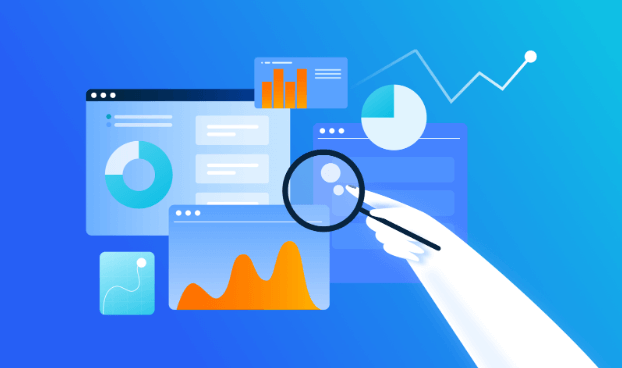
Data-Driven Decision Making: How Analytics Drives Digital Marketing
By Udit Agarwal

In the fast-paced and ever-evolving digital marketing landscape, we cannot overstate the importance of data-driven decision-making. In an era where information is the key to success, analytics has become the driving force behind effective digital marketing strategies. This comprehensive guide delves into data-driven decision-making, explaining its significance, processes, and real-world applications within digital marketing.
The Significance of Data-Driven Decision Making
Data-driven decision-making involves using data and analytics to guide strategic choices and actions. It represents a shift from making decisions based on intuition or experience to utilizing insights derived from an organization’s data. In digital marketing, data-driven decision–making offers several advantages:
1. Precision in Targeting: Marketers can segment their audience into particular groups by analyzing data, ensuring that marketing efforts reach the right people with the right message.
2. Improved ROI: Data-driven campaigns are more efficient, reducing marketing spend on unproductive strategies and increasing return on investment (ROI).
3. Personalization: Analyzing data enables the customization of content and offers, enhancing user experience and engagement.
4. Real-Time Adaptation: Data-driven marketing allows quick adjustments in response to shifting consumer behaviors and market trends.
5. Competitive Edge: Businesses that utilize data-driven decision–making gain a competitive edge by staying agile and responsive in the digital landscape.
The Process of Data-Driven Decision Making
Data Collection: The process begins with collecting data from various sources, such as websites, social media, email marketing, and customer interactions.
Storage: We securely store collected data, often in data warehouses or databases, where it is readily available for analysis.
Analysis: Advanced analytics tools and software are used to analyze the data, uncover patterns, and derive actionable insights.
Decision-Making: Data analysis guides marketing decisions, helping organizations tailor their strategies to meet objectives and obtain insights.
Implementation: To optimize results and execute decisions through marketing campaigns, content creation, or product development.
Monitoring: The process is cyclical, continuously monitoring the results and adjustments based on ongoing data analysis.

Real-World Applications
1. Content Optimization: Data-driven insights help marketers understand which content types, formats, and distribution channels are most effective in engaging the target audience. This knowledge guides content creation and distribution strategies.
2. Customer Segmentation: Marketers can segment their customer base through data analysis into groups with similar preferences and behaviors. It allows for personalized marketing campaigns and product recommendations.
3. Email Marketing: Using data to tailor content, delivery times, and subject lines to individual recipients increases open rates and conversions, making email campaigns more effective.
4. SEO and SEM: Data-driven decision-making enhances search engine optimization (SEO) and marketing (SEM) strategies. Marketers can identify the most valuable keywords and create content that ranks well in search results.
5. Social Media Advertising: Marketers can optimize ad targeting and create content that resonates with their audience by analyzing user behavior and engagement on social media platforms.
6. Conversion Rate Optimization: Data-driven insights can uncover bottlenecks and obstacles in the customer journey, allowing marketers to optimize websites and landing pages to improve conversion rates.
7. Performance Metrics: Regular tracking of key performance indicators (KPIs) provides a clear view of the effectiveness of marketing efforts. Data-driven insights inform adjustments to campaigns for better results.
8. A/B Testing: In data-driven marketing, real users test two or more versions of a campaign or webpage, heavily relying on A/B testing. Data analysis reveals which version performs better, helping in decision-making.
9. Predictive Analytics: Advanced data analysis techniques can forecast future trends and customer behavior, allowing organizations to adjust their strategies proactively.
10. Reporting and Dashboards: Customized reports and dashboards provide real-time data visualization, making it easier for marketers to understand the impact of their strategies.
Challenges in Data-Driven Decision Making
While data-driven decision-making is invaluable in digital marketing, it comes with challenges, such as:
1. Data Quality: The accuracy and reliability of data can vary, affecting the quality of insights.
2. Privacy Concerns: Stricter data privacy regulations require marketers to navigate a complex landscape when collecting and using customer data.
3. Skill Requirements: Successful data-driven marketing requires a skilled team or access to data analysts, which can be resource-intensive.
4. Data Integration: Marketers often deal with data from various sources, making data integration and centralization a key challenge.
5. Continuous Learning: The digital landscape is ever-changing. Marketers must keep pace with new tools, techniques, and algorithms.
Conclusion
Data-driven decision-making is the driving force behind effective digital marketing strategies. Marketers can make informed decisions by collecting, analyzing, and leveraging data, resulting in more precise targeting, improved ROI, and personalized user experiences. As the digital landscape continues to evolve, embracing data-driven decision-making is not just advantageous; it’s essential for businesses aiming to stay competitive and responsive to the ever-changing market dynamics.